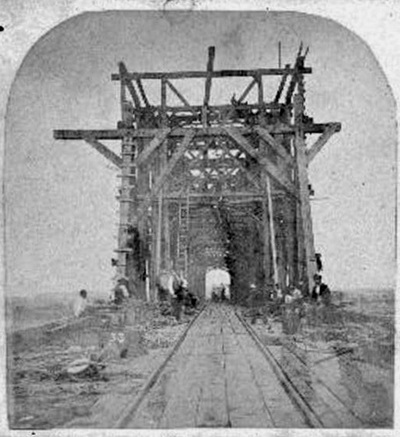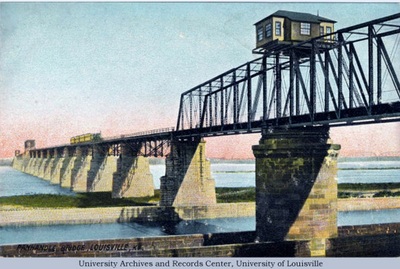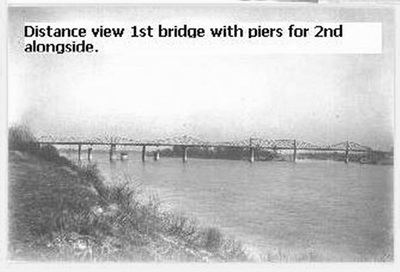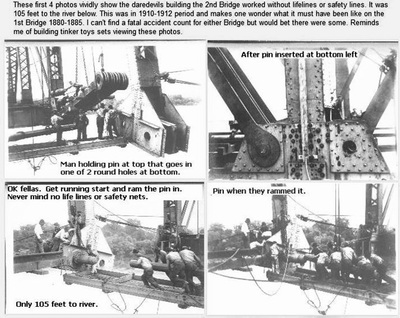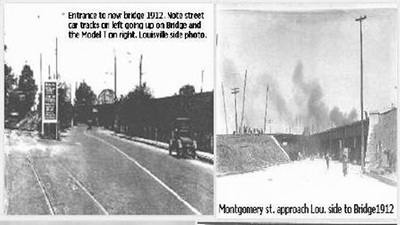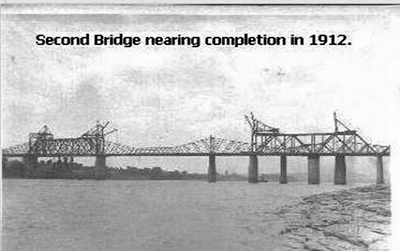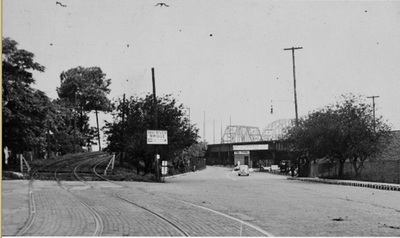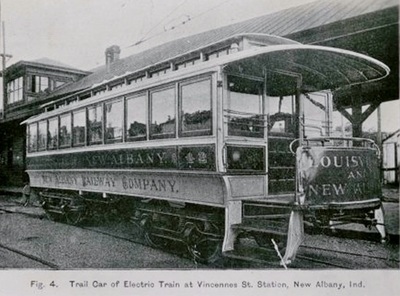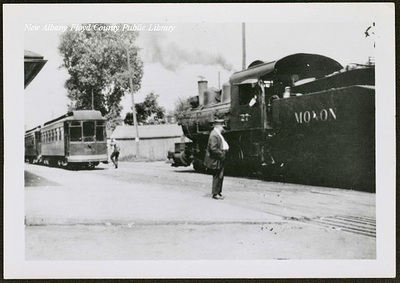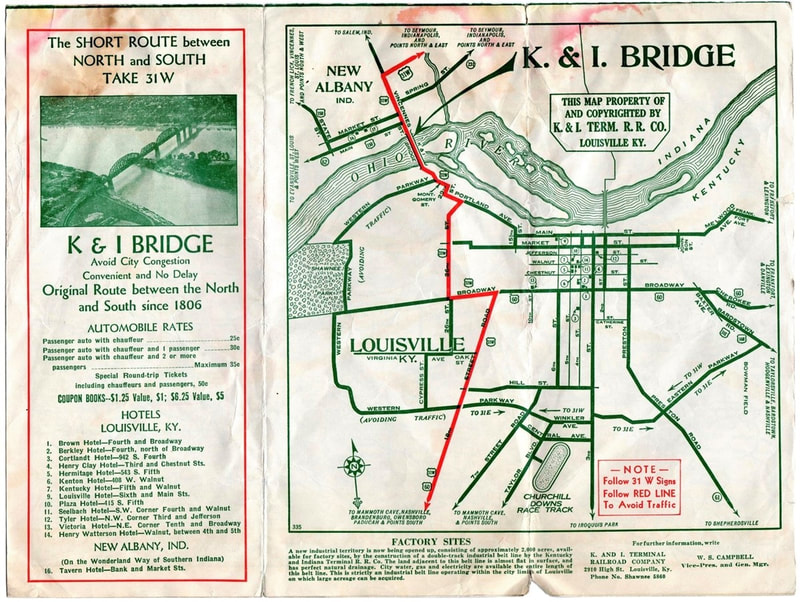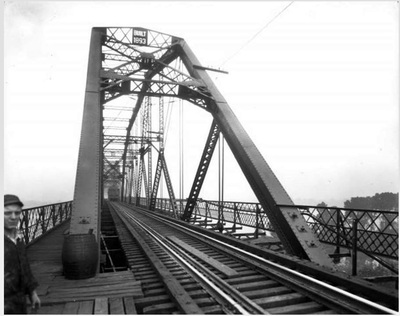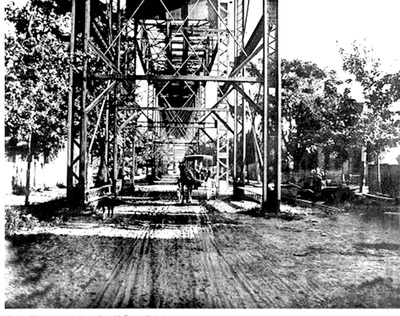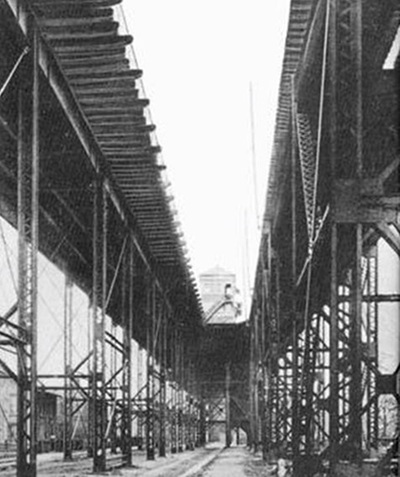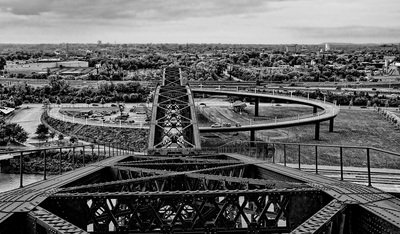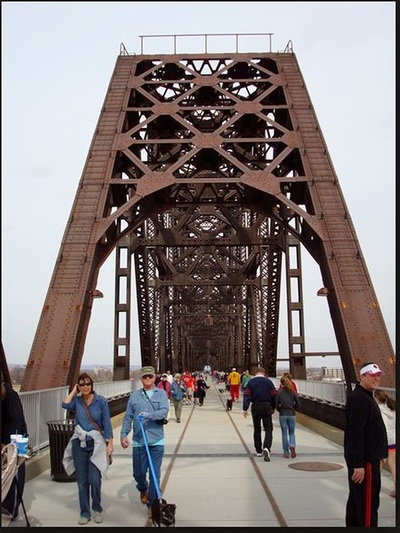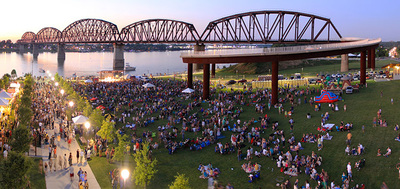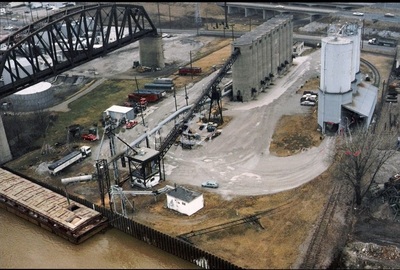The Three Railroad Bridges over the Ohio River
Some photos are poor quality when enlarged
Hover over image to see caption. Click for larger image and a manual slide show with captions. Keyboard arrows can be used
The Fourteenth Street Bridge Built in 1870 and rebuilt in 1919 0n the same piers
The Fourteenth Street (iron) Bridge was completed in 1870. A stronger steel superstructure was built on the same piers in 1919.
The Fourteenth Street Bridge also known as The Pennsylvania Railroad Bridge marks the eastern boundary of The Falls of the Ohio State Park. It is at the head of the canal that leads to the McAlpine Locks and Dam.
By the 1860s, the Louisville and Nashville Railroad and the Jeffersonville and Indianapolis Railroad both desired a railroad bridge across the river. There were no bridges across the Ohio River at Cincinnati or any place west, including Louisville. The United States Congress approved the building of the bridge in February, 1865.
The L&N Railroad financed the Louisville Bridge Company to build the bridge and construction began on August 1, 1867. It was to become the longest iron bridge in the United States 27 spans covering a mile. The first train crossed the bridge on February 18, 1870.
The Pennsylvania Railroad purchased the L&N's 60% ownership of the bridge in the mid-1870s. By the 1900s the bridge was being used 300 times a day, putting more stress on the bridge. Between 1916 and 1919 a new single-track steel superstructure was placed on the old stone piers. A vertical-lift span replaced the swing span that was above the canal.
The bridge was operated for many years by the Pennsylvania Railroad. In 1968 the Pennsylvania Railroad and the New York Central Railroad merged to become Penn Central. Eight years later, it was placed under Conrail. The Louisville & Indiana Railroad purchased the Jeffersonville to Indianapolis line and bridge from Conrail in March 1994. The Louisville and Indiana Railroad is the current bridge owner.
The Fourteenth Street (iron) Bridge was completed in 1870. A stronger steel superstructure was built on the same piers in 1919.
The Fourteenth Street Bridge also known as The Pennsylvania Railroad Bridge marks the eastern boundary of The Falls of the Ohio State Park. It is at the head of the canal that leads to the McAlpine Locks and Dam.
By the 1860s, the Louisville and Nashville Railroad and the Jeffersonville and Indianapolis Railroad both desired a railroad bridge across the river. There were no bridges across the Ohio River at Cincinnati or any place west, including Louisville. The United States Congress approved the building of the bridge in February, 1865.
The L&N Railroad financed the Louisville Bridge Company to build the bridge and construction began on August 1, 1867. It was to become the longest iron bridge in the United States 27 spans covering a mile. The first train crossed the bridge on February 18, 1870.
The Pennsylvania Railroad purchased the L&N's 60% ownership of the bridge in the mid-1870s. By the 1900s the bridge was being used 300 times a day, putting more stress on the bridge. Between 1916 and 1919 a new single-track steel superstructure was placed on the old stone piers. A vertical-lift span replaced the swing span that was above the canal.
The bridge was operated for many years by the Pennsylvania Railroad. In 1968 the Pennsylvania Railroad and the New York Central Railroad merged to become Penn Central. Eight years later, it was placed under Conrail. The Louisville & Indiana Railroad purchased the Jeffersonville to Indianapolis line and bridge from Conrail in March 1994. The Louisville and Indiana Railroad is the current bridge owner.
K & I Bridge Built in 1886 and rebuilt in 1911
The first K & I Bridge connecting Louisville and New Albany was constructed from 1881 to 1885 and opened in 1886. Originally, it included a single track and two wagon ways allowing wagons and other animal powered vehicles to cross the river other than by ferry. Motorized vehicles were virtually nonexistent.
Upon opening, the bridge company also offered the Daisy Line, an early steam locomotive commuter train service. (cars were painted yellow with brown trimming, resembling a black-eyed susan, hence the name). In 1893 the Daisy Line trains became electrified, the first steam to electric conversion in the U.S., even preceded the electrification of the famous Chicago's 'L' trains by two years.
Passengers traveled in multi-unit three-car elevated electric trains from 1st, 4th and 7th Street elevated stations plus other stations between Louisville and New Albany. This rapid transit service was wildly popular, with its 15 minute service and convenient schedules from 6am to midnight. By 1906 a survey found 3,425 commuter passengers crossing daily and 1,250,000 per year on these rapid electric trains. The last commuter train crossed the K & I Bridge in December, 1945.
In 1910 the bridge company was renamed the Kentucky & Indiana Terminal Railroad Co. From 1910 to 1911, the bridge was rebuilt and double tracked to handle increasingly heavier train and now automobile traffic,
The bridge also featured a rotating swing span opening for the passage of ships in high water. The bridge was only opened four times, twice for testing in 1913 and 1915, then in 1916 for the passage of the steamer "Tarascon" and in 1920 for passage of the Australian convict ship "Success". In 1955 the K&I sought and received permission to permanently tie down the swing span from the Corps of Engineers.
In 1979, an overweight dump truck caused a small segment of the steel grate roadway to sag about 1 foot. Workers quickly repaired the roadway deck but automotive traffic was banned thereafter by the bridge owner.
Some photos are of poor quality.
The first K & I Bridge connecting Louisville and New Albany was constructed from 1881 to 1885 and opened in 1886. Originally, it included a single track and two wagon ways allowing wagons and other animal powered vehicles to cross the river other than by ferry. Motorized vehicles were virtually nonexistent.
Upon opening, the bridge company also offered the Daisy Line, an early steam locomotive commuter train service. (cars were painted yellow with brown trimming, resembling a black-eyed susan, hence the name). In 1893 the Daisy Line trains became electrified, the first steam to electric conversion in the U.S., even preceded the electrification of the famous Chicago's 'L' trains by two years.
Passengers traveled in multi-unit three-car elevated electric trains from 1st, 4th and 7th Street elevated stations plus other stations between Louisville and New Albany. This rapid transit service was wildly popular, with its 15 minute service and convenient schedules from 6am to midnight. By 1906 a survey found 3,425 commuter passengers crossing daily and 1,250,000 per year on these rapid electric trains. The last commuter train crossed the K & I Bridge in December, 1945.
In 1910 the bridge company was renamed the Kentucky & Indiana Terminal Railroad Co. From 1910 to 1911, the bridge was rebuilt and double tracked to handle increasingly heavier train and now automobile traffic,
The bridge also featured a rotating swing span opening for the passage of ships in high water. The bridge was only opened four times, twice for testing in 1913 and 1915, then in 1916 for the passage of the steamer "Tarascon" and in 1920 for passage of the Australian convict ship "Success". In 1955 the K&I sought and received permission to permanently tie down the swing span from the Corps of Engineers.
In 1979, an overweight dump truck caused a small segment of the steel grate roadway to sag about 1 foot. Workers quickly repaired the roadway deck but automotive traffic was banned thereafter by the bridge owner.
Some photos are of poor quality.
The Big Four Bridge Built in 1895 and rebuilt 1929 on the same piers
A Louisville to Jeffersonville bridge was first conceived in Jeffersonville in 1885. The Louisville and Jeffersonville Bridge Company was formed in 1887 to construct a bridge. Construction began on October 10, 1888 and finally completed in 1895.
Due to various accidents and the cost of construction, the Louisville and Jeffersonville Bridge Company was financially strapped and in 1895 sold the bridge to the Indianapolis-based Cleveland, Cincinnati, Chicago and St. Louis Railway, also known as the Big Four Railroad. Hence the bridge became known as The Big Four Bridge.
Due to the increasing weight of the rail traffic a bigger, stronger Big Four Bridge was built and opened in 1929. The new bridge was built on the piers of the old bridge.
The first interurban crossed the Big Four Bridge on September 12, 1905 . In January 1918, two interurban collided on the Big Four Bridge, killing three and injuring twenty.
Death on the Big Four
Thirty-seven men died during the construction of the Big Four. The first twelve died while working on a pier foundation when a caisson that was supposed to hold back the river water flooded, drowning the workers. Another four men died a few months after that when a wooden beam broke while working on a different pier caisson.
The Big Four Bridge had one of the biggest bridge disasters in the United States on December 15, 1893 when a construction crane was dislodged by a severe wind, causing the falsework support of a truss to be damaged and the truss—with forty-one workers on it—to fall into the Ohio River. Twenty of the workers survived, but twenty-one died. The accident almost cost more lives, as a ferry crossing the Ohio River just barely missed being hit by the truss. Hours later, a span next to the damaged span also fell into the river, but was abandoned at the time, causing no injuries.
The Big Four Bridge fell into disuse after the Big Four Railroad's parent company, the New York Central Railroad, was merged into the Penn Central in 1968. The Big Four Bridge's former traffic was then routed over the Fourteenth Street Bridge. Both approach spans were removed and sold for scrap.
It is now a converted pedestrian walkway between Louisville and Jeffersonville, Indiana.
A Louisville to Jeffersonville bridge was first conceived in Jeffersonville in 1885. The Louisville and Jeffersonville Bridge Company was formed in 1887 to construct a bridge. Construction began on October 10, 1888 and finally completed in 1895.
Due to various accidents and the cost of construction, the Louisville and Jeffersonville Bridge Company was financially strapped and in 1895 sold the bridge to the Indianapolis-based Cleveland, Cincinnati, Chicago and St. Louis Railway, also known as the Big Four Railroad. Hence the bridge became known as The Big Four Bridge.
Due to the increasing weight of the rail traffic a bigger, stronger Big Four Bridge was built and opened in 1929. The new bridge was built on the piers of the old bridge.
The first interurban crossed the Big Four Bridge on September 12, 1905 . In January 1918, two interurban collided on the Big Four Bridge, killing three and injuring twenty.
Death on the Big Four
Thirty-seven men died during the construction of the Big Four. The first twelve died while working on a pier foundation when a caisson that was supposed to hold back the river water flooded, drowning the workers. Another four men died a few months after that when a wooden beam broke while working on a different pier caisson.
The Big Four Bridge had one of the biggest bridge disasters in the United States on December 15, 1893 when a construction crane was dislodged by a severe wind, causing the falsework support of a truss to be damaged and the truss—with forty-one workers on it—to fall into the Ohio River. Twenty of the workers survived, but twenty-one died. The accident almost cost more lives, as a ferry crossing the Ohio River just barely missed being hit by the truss. Hours later, a span next to the damaged span also fell into the river, but was abandoned at the time, causing no injuries.
The Big Four Bridge fell into disuse after the Big Four Railroad's parent company, the New York Central Railroad, was merged into the Penn Central in 1968. The Big Four Bridge's former traffic was then routed over the Fourteenth Street Bridge. Both approach spans were removed and sold for scrap.
It is now a converted pedestrian walkway between Louisville and Jeffersonville, Indiana.






